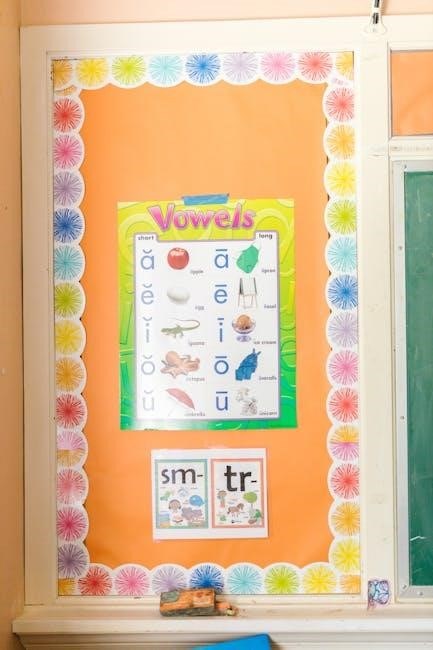The 2023 PALS Study Guide PDF is a comprehensive resource for healthcare professionals‚ offering updated pediatric emergency care protocols and life-saving techniques aligned with AHA guidelines.
1.1 Overview of the PALS Program and Its Importance
The Pediatric Advanced Life Support (PALS) program is a critical training initiative for healthcare professionals‚ focusing on managing life-threatening emergencies in children. Updated annually‚ the 2023 PALS Study Guide PDF reflects the latest advancements in pediatric care‚ ensuring providers are equipped with evidence-based practices. It emphasizes systematic approaches‚ shock management‚ and respiratory emergencies‚ making it indispensable for improving patient outcomes and enhancing clinical decision-making skills in high-stakes situations.
1.2 Key Features of the 2023 PALS Study Guide
The 2023 PALS Study Guide PDF offers updated algorithms‚ case studies‚ and practice tests‚ ensuring healthcare professionals are well-prepared for pediatric emergencies. It includes interactive learning tools‚ such as visual aids and simulations‚ to enhance understanding and retention. The guide also provides structured learning pathways‚ allowing users to tailor their study experience. With a focus on real-world applications‚ the 2023 edition emphasizes practical skills and decision-making‚ making it an essential resource for improving patient outcomes and exam readiness.

Key Topics Covered in the PALS Study Guide 2023
The 2023 PALS Study Guide covers systematic assessment algorithms‚ shock management‚ respiratory emergencies‚ pharmacology‚ and updated AHA guidelines‚ ensuring comprehensive preparation for pediatric life support scenarios.
2.1 PALS Systematic Approach Algorithm
The PALS Systematic Approach Algorithm is a structured method for assessing and managing critically ill or injured children. It begins with an initial impression to identify life-threatening conditions‚ followed by a primary assessment focusing on airway‚ breathing‚ circulation‚ disability‚ and exposure (ABCDE). The algorithm then progresses to a secondary assessment‚ including a detailed physical exam and diagnostic tests. This approach ensures a comprehensive evaluation‚ guiding interventions for shock‚ respiratory distress‚ or cardiac arrest. It emphasizes timely recognition and management‚ integrating seamlessly with other PALS algorithms to optimize patient outcomes in dynamic pediatric emergencies.
2.2 Management of Shock in Pediatric Patients
Managing shock in pediatric patients involves prompt recognition and tailored interventions. The PALS Study Guide emphasizes identifying shock through clinical signs such as tachycardia‚ poor perfusion‚ and decreased consciousness. Classification into distributive‚ cardiogenic‚ hypovolemic‚ or obstructive shock guides specific therapies. Initial management includes fluid boluses‚ oxygen‚ and addressing underlying causes. Vasopressors or inotropes may be required for refractory cases. Continuous monitoring of vital signs and tissue perfusion ensures adjustments in therapy. Early recognition and intervention are critical to prevent progression and improve outcomes in pediatric shock scenarios‚ aligning with updated AHA guidelines for effective care.
The PALS Systematic Approach
The PALS systematic approach begins with a quick assessment to determine if a child is in imminent danger of cardiac arrest or respiratory failure‚ ensuring structured care.
3.1 Initial Assessment and Impression
The initial assessment in the PALS systematic approach involves a quick evaluation to identify if a child is in imminent danger‚ such as cardiac arrest or respiratory failure. This step is critical for guiding immediate interventions. The process begins with observing the child’s general appearance‚ followed by assessing vital signs and respiratory status. The primary assessment focuses on airway‚ breathing‚ and circulation (ABCs)‚ while also evaluating disability (neurological status) and exposure (environmental factors). This structured approach ensures that healthcare providers can rapidly identify life-threatening conditions and prioritize care effectively‚ aligning with the latest AHA guidelines.
3.2 Primary and Secondary Assessments
The primary assessment focuses on the child’s airway‚ breathing‚ circulation‚ disability‚ and exposure (ABCs)‚ identifying life-threatening conditions requiring immediate intervention. The secondary assessment involves a detailed physical exam‚ patient history‚ and diagnostic tests to gather comprehensive information. This structured approach ensures a thorough evaluation‚ guiding targeted interventions and improving patient outcomes in pediatric emergencies.

Management of Shock
Management of shock involves fluid resuscitation‚ vasoactive medications‚ and addressing underlying causes. The PALS shock algorithm provides a structured approach to stabilize pediatric patients effectively.
4.1 Recognition and Classification of Shock
Recognition and classification of shock are critical in pediatric care. Shock is categorized into hypovolemic‚ cardiogenic‚ distributive‚ and obstructive types. Early detection of signs like tachycardia‚ tachypnea‚ and poor perfusion is vital. The 2023 PALS Study Guide emphasizes updated criteria for identifying shock stages‚ from compensated to decompensated‚ ensuring timely intervention. Understanding these classifications helps guide appropriate fluid resuscitation‚ vasoactive medication use‚ and other targeted therapies‚ improving outcomes in critically ill children. The guide also provides case-based examples to aid in accurate diagnosis and management.
4.2 Shock Management Flowchart
The 2023 PALS Study Guide includes a detailed shock management flowchart‚ providing a structured approach to pediatric shock care. It begins with airway‚ breathing‚ and circulation assessment‚ followed by shock type identification. The flowchart outlines fluid resuscitation‚ vasoactive medication use‚ and monitoring protocols. It emphasizes tailored interventions for hypovolemic‚ cardiogenic‚ distributive‚ and obstructive shock. This visual tool aids in systematic decision-making‚ ensuring adherence to AHA guidelines and optimizing patient outcomes. Regular updates reflect current best practices‚ making it an indispensable resource for healthcare providers managing critically ill children.

Respiratory Emergencies in Pediatrics
The PALS Study Guide 2023 PDF provides critical strategies for managing pediatric respiratory emergencies‚ including assessment of distress and interventions to prevent respiratory failure.
5.1 Assessment of Respiratory Distress
Assessing respiratory distress in pediatric patients involves recognizing clinical signs such as abnormal respiratory rates‚ retractions‚ nasal flaring‚ and decreased oxygen saturation. The PALS Study Guide 2023 PDF emphasizes the importance of early detection through physical examination and diagnostic tools like pulse oximetry and capnography. Understanding these indicators helps guide immediate interventions‚ ensuring timely and effective care for children experiencing respiratory compromise.
5.2 Interventions for Respiratory Failure
For pediatric respiratory failure‚ the 2023 PALS Study Guide emphasizes timely interventions such as oxygen therapy‚ Bag-Valve-Mask (BVM) ventilation‚ and endotracheal intubation. Mechanical ventilation and non-invasive methods like CPAP or BiPAP are also critical. Pharmacological support‚ including bronchodilators and corticosteroids‚ may be necessary. Continuous monitoring of oxygen saturation and respiratory mechanics is essential to guide therapy and prevent complications. These interventions are tailored to the child’s condition‚ ensuring effective management and improving outcomes in acute respiratory distress situations.

Pharmacology in PALS
The PALS Study Guide 2023 PDF outlines essential medications for pediatric emergencies‚ such as epinephrine‚ atropine‚ and dopamine‚ highlighting their roles in improving cardiac output and perfusion.
6.1 Essential Medications and Dosages
The 2023 PALS Study Guide emphasizes critical medications for pediatric emergencies‚ including epinephrine‚ atropine‚ dopamine‚ and amiodarone. Dosages are tailored to pediatric physiology‚ with precise calculations based on weight. Epinephrine is administered at 0.01 mg/kg for cardiac arrest‚ while dopamine is used for shock management starting at 5-10 mcg/kg/min. Proper dosing ensures efficacy and minimizes adverse effects‚ highlighting the importance of accurate weight-based calculations in pediatric care. These medications are vital for stabilizing heart rate‚ improving perfusion‚ and restoring cardiac function in critically ill children.
6.2 Drug Administration Techniques
The 2023 PALS Study Guide provides detailed insights into effective drug administration techniques for pediatric emergencies. Intravenous (IV) administration is emphasized for rapid drug delivery‚ while intraosseous (IO) access is recommended when IV is unattainable. Endotracheal (ET) administration is noted for specific medications like epinephrine in cardiac arrest scenarios. The guide also covers titration techniques for continuous infusions‚ such as dopamine or norepinephrine‚ to manage shock. Proper dosing‚ dilution‚ and administration rates are stressed to ensure safety and efficacy in pediatric care‚ minimizing risks of adverse effects during critical situations.

PALS Algorithms
The 2023 PALS Study Guide outlines critical algorithms for managing pediatric emergencies‚ providing step-by-step protocols for shock‚ respiratory distress‚ and cardiac arrest scenarios to guide healthcare professionals effectively.
7.1 Shock Algorithm
The Shock Algorithm in the 2023 PALS Study Guide provides a structured approach to identifying and managing pediatric shock. It begins with recognizing signs of compensated and decompensated shock‚ followed by initial assessments of airway‚ breathing‚ and circulation. The algorithm emphasizes the importance of the “shock bundle‚” including fluid resuscitation‚ oxygen therapy‚ and vasoactive medications. It also incorporates the “CAST” approach: Circulation‚ Airway‚ Shock‚ and Tubes. The guide updates shock management protocols‚ ensuring evidence-based interventions for improved patient outcomes‚ aligned with the latest AHA guidelines and practical case scenarios.
7.2 Respiratory Emergency Algorithm
The Respiratory Emergency Algorithm in the 2023 PALS Study Guide provides a systematic approach to managing pediatric respiratory emergencies. It begins with assessing the severity of respiratory distress‚ including clinical signs like retractions‚ wheezing‚ and oxygen saturation levels. The algorithm guides interventions such as oxygen therapy‚ airway management‚ and pharmacological treatments like bronchodilators or corticosteroids. It emphasizes the importance of monitoring and escalation to advanced therapies‚ such as mechanical ventilation‚ if respiratory failure occurs. The guide includes updated protocols and case examples to enhance practical application and improve outcomes for critically ill children.
7.3 Integration of Algorithms in Practice
The 2023 PALS Study Guide emphasizes the integration of algorithms into real-world practice‚ ensuring seamless application during pediatric emergencies. It provides clear‚ step-by-step approaches for managing shock‚ respiratory distress‚ and cardiac issues. Case studies and practical examples illustrate how to apply these algorithms effectively. The guide also highlights the importance of updating skills with the latest AHA protocols. By integrating these algorithms‚ healthcare providers can improve decision-making and patient outcomes‚ ensuring timely and appropriate interventions in critical situations. This approach aligns with evidence-based practices and enhances proficiency in pediatric life support.

PALS Practice Tests and Exam Preparation
The 2023 PALS Study Guide includes practice tests with multiple-choice questions‚ simulating real exam scenarios to assess knowledge and readiness for certification‚ ensuring comprehensive exam preparation.
8.1 Features of PALS Practice Tests
The 2023 PALS Study Guide includes practice tests designed to simulate real exam scenarios‚ featuring multiple-choice questions that assess knowledge of pediatric emergency care. These tests cover key topics such as shock management‚ respiratory emergencies‚ and pharmacology‚ ensuring a comprehensive review of critical concepts. The practice tests are structured to follow the PALS systematic approach‚ allowing healthcare professionals to apply their skills in a controlled environment. Each test is graded‚ providing immediate feedback and highlighting areas for improvement. This feature helps users gauge their readiness for the certification exam and reinforces learning effectively.
8;2 Benefits of Pre-Test Assessments
Pre-test assessments in the 2023 PALS Study Guide offer numerous benefits‚ enabling healthcare professionals to identify knowledge gaps and strengthen their understanding of pediatric emergency care. These assessments provide a realistic preview of the certification exam‚ familiarizing users with the format and content. By highlighting areas needing improvement‚ pre-tests allow focused study‚ enhancing overall preparedness. Additionally‚ they build confidence and reduce exam anxiety‚ ensuring professionals are well-equipped to apply lifesaving skills effectively in real-world scenarios. Regular use of pre-tests optimizes learning outcomes and improves retention of critical PALS concepts.
Updates from the American Heart Association (AHA) 2023
The 2023 AHA updates include new PALS guidelines‚ revised algorithms‚ and evidence-based practices to enhance pediatric emergency care and improve patient outcomes effectively.
9.1 Changes in PALS Guidelines for 2023
The 2023 PALS guidelines introduce updated algorithms for shock and respiratory emergencies‚ emphasizing evidence-based practices. New drug dosages and protocols reflect the latest research‚ improving pediatric care outcomes. These changes include refined assessment techniques and integrated case studies to enhance clinical decision-making. The updates align with advancements in pediatric life support‚ ensuring healthcare providers deliver cutting-edge care. The revised guidelines also emphasize the importance of timely interventions and multidisciplinary collaboration‚ further solidifying the framework for managing critically ill children effectively.
9.2 New Algorithms and Protocols
The 2023 PALS Study Guide introduces updated algorithms and protocols‚ including enhanced shock management and respiratory emergency workflows. These evidence-based updates streamline decision-making processes‚ ensuring timely and effective interventions. New flowcharts and case-based scenarios are integrated to facilitate practical application. The protocols emphasize early recognition of critical conditions and standardized treatment approaches. These advancements aim to improve outcomes in pediatric care by providing clear‚ actionable steps for healthcare providers. The updated algorithms reflect the latest research and clinical best practices‚ making them indispensable for professionals seeking to deliver optimal patient care.

How to Use the PALS Study Guide Effectively
The 2023 PALS Study Guide is best utilized through structured learning‚ leveraging practice tests for self-assessment and reinforcing key concepts for enhanced retention and exam success.
10.1 Structured Learning Approach
A structured learning approach with the 2023 PALS Study Guide involves systematic review of algorithms‚ case studies‚ and pharmacology; This method ensures healthcare professionals master pediatric emergency care protocols efficiently‚ improving patient outcomes through evidence-based practices and updated guidelines. Regular practice tests and pre-test assessments enhance understanding and retention‚ preparing individuals for real-life scenarios and certification exams. By following this approach‚ learners can effectively integrate new knowledge into clinical practice‚ ensuring they are well-prepared to handle critical situations confidently. This organized method maximizes learning potential and supports long-term competency in pediatric advanced life support.
10.2 Utilizing Additional Resources
Supplementing the PALS Study Guide with additional resources enhances learning effectiveness. Online practice tests‚ algorithm charts‚ and interactive simulations provide hands-on experience. Video tutorials and case studies offer practical insights‚ while group discussions and role-playing activities foster collaboration and real-world application. These resources help reinforce concepts‚ improve retention‚ and prepare professionals for emergencies. By integrating these tools‚ learners can deepen their understanding of pediatric advanced life support and apply their knowledge confidently in critical situations. Utilizing these resources ensures a well-rounded and practical approach to mastering the PALS curriculum.

Case Studies and Real-World Applications
The 2023 PALS Study Guide includes practical case studies and real-life scenarios‚ enabling healthcare professionals to apply theoretical knowledge to actual patient care situations effectively.
11.1 Practical Examples from the 2023 Guide
The 2023 PALS Study Guide provides diverse case studies‚ such as managing pediatric shock and respiratory distress‚ offering real-world applications of algorithms and treatment protocols. These examples guide healthcare professionals in assessing and intervening effectively in critical situations‚ ensuring optimal patient outcomes through evidence-based practices and updated AHA guidelines.
11.2 Learning from Real-Life Scenarios
The 2023 PALS Study Guide incorporates real-life scenarios to enhance learning‚ enabling healthcare professionals to apply theoretical knowledge in practical situations. These scenarios simulate critical pediatric emergencies‚ such as cardiac arrest or respiratory failure‚ allowing learners to practice decision-making and intervention techniques. By analyzing these cases‚ professionals can refine their skills in assessing conditions‚ prioritizing actions‚ and improving patient outcomes‚ ensuring they are well-prepared for real-world challenges in pediatric care.

Interactive and Engaging Learning Methods
The 2023 PALS Study Guide incorporates interactive learning methods‚ such as visual aids‚ simulations‚ and group discussions‚ to enhance engagement and practical skill application in pediatric emergency care.
12.1 Use of Visual Aids and Simulations
The 2023 PALS Study Guide effectively utilizes visual aids and simulations to enhance learning. High-quality diagrams‚ flowcharts‚ and videos provide clear representations of complex concepts‚ such as shock algorithms and respiratory assessments. Simulations offer hands-on practice‚ allowing healthcare professionals to apply their knowledge in realistic pediatric emergency scenarios. These tools improve retention‚ critical thinking‚ and decision-making skills‚ ensuring better preparedness for real-life situations. Interactive simulations also cater to diverse learning styles‚ making the study guide a dynamic and engaging resource for mastering pediatric advanced life support techniques.
12.2 Group Discussions and Role-Playing
Group discussions and role-playing are integral to the 2023 PALS Study Guide‚ fostering collaborative learning and practical application of skills. These activities encourage healthcare professionals to engage in problem-solving‚ share experiences‚ and refine communication. Role-playing simulations replicate real-life pediatric emergencies‚ allowing participants to practice algorithms and decision-making in a safe environment. This interactive approach enhances teamwork‚ critical thinking‚ and adaptability‚ ensuring providers are well-prepared to handle high-stakes situations effectively. Such methods make learning dynamic and applicable‚ bridging the gap between theory and clinical practice.
